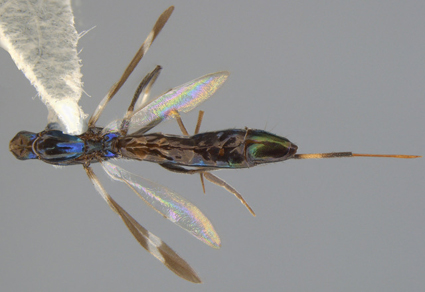Abstract
The genus Xenanastatus Bouček (Hymenoptera: Eupelmidae) is recorded for the first time in China based on a newly described species, X. imbricatius Wu & Peng sp. nov. The new species is described and illustrated based on females from Guangdong province; internal transcribed spacer 2 (ITS2) and partial mitochondrial cytochrome oxidase subunit I (COI) and 28S ribosomal DNA (28S) sequences are provided. The world species of Xenanastatus are differentiated in a key based on females.
References
- Al khatib, F., Cruaud, A., Fusu, L., Cruaud, A., Gibson, G., Borowiec, N., Rasplus, J.-Y., Ris, N. & Delvare, G. (2014) An integrative approach to species discrimination in the Eupelmus urozonus complex (Hymenoptera, Eupelmidae), with the description of 11 new species from the Western Palaearctic. Systematic Entomology, 39 (4), 806–862. https://doi.org/10.1111/syen.12089
- Bouček, Z. (1988) Australasian Chalcidoidea (Hymenoptera). A biosystematic revision of genera of fourteen families, with a reclassification of species. CAB International, Wallingford, 832 pp.
- Folmer, O., Black, M., Hoeh, W., Lutz, R. & Vrijenhoek, R. (1994) DNA primers for amplification of mitochondrial Cytochrome C oxidase subunit I from diverse metazoan invertebrates. Molecular Marine Biology and Biotechnology, 3 (5), 294–299.
- Gibson, G.A.P. (1995) Parasitic wasps of the subfamily Eupelminae: classification and revision of world genera (Hymenoptera: Chalcidoidea: Eupelmidae). Memoirs on Entomology, International, 5, 1–421.
- Gibson, G.A.P. & Fusu, L. (2016) Revision of the Palaearctic species of Eupelmus (Eupelmus) Dalman (Hymenoptera: Chalcidoidea: Eupelmidae). Zootaxa, 4081 (1), 1–331. https://doi.org/10.11646/zootaxa.4081.1.1
- Hall, T.A. (1999) BioEdit: a user-friendly biological sequence alignment editor and analysis program for Windows 95/98/NT. Nuclic Acids Symposium Series, 41, 95‒98.
- Katoh, K., Rozewicki, J. & Yamada, K.D. (2019) MAFFT online service: multiple sequence alignment, interactive sequence choice and visualization. Briefings in Bioinformatics, 20, 1160‒1166. https://doi.org/10.1093/bib/bbx108
- Li,Y., Zhou, X., Feng, G., Hu, H., Niu, L., Hebert, P.D.N. & Huang, D. (2010) COI and ITS2 sequences delimit species, reveal cryptic taxa and host specificity of fig-associated Sycophila (Hymenoptera, Eurytomidae). Molecular Ecology Resources, 10, 31–40. https://doi.org/10.1111/j.1755-0998.2009.02671.x
- Munro, J.B., Heraty, J.M., Burks, R.A., Hawks, D., Mottern, J., Cruaud, A., Rasplus, J.-Y. & Jansta, P. (2011) A molecular phylogeny of the Chalcidoidea (Hymenoptera). Plos one, 6 (11), e27023. https://doi.org/10.1371/journal.pone.0027023
- Narendran, T.C. (1998) Two new species of the rare genus Xenanastatus Bouček and a key to species from the Indo-Australian region. Senckenbergiana Biologica, 77 (2), 205–209.
- Noyes, J.S. (2019) Universal Chalcidoidea Database. Available from: http://www.nhm.ac.uk/chalcidoids (accessed 30 April 2023)
- Schoch, C.L., Ciufo, S., Domrachev, M., Hotton, C.L., Kannan, S., Khovanskaya, R., Leipe, D., Mcveigh, R., O’Neill, K., Robbertse, B., Sharma, S., Soussov, V., Sullivan, J.P., Sun, L., Turner, S. & Karsch-Mizrachi, I. (2020) NCBI Taxonomy: a comprehensive update on curation, resources and tools. Database, 2020, baaa062. Available from: https://www.ncbi.nlm.nih.gov/taxonomy (accessed 30 April 2023) https://doi.org/10.1093/database/baaa062
- White, T.J., Bruns, T.D., Lee, S.B. & Taylor, J.W. (1990) Amplification and direct sequencing of fungal ribosomal RNA genes for phylogenetics. In: PCR Protocols: A Guide to Methods and Applications, 18, 315–322. https://doi.org/10.1016/B978-0-12-372180-8.50042-1


